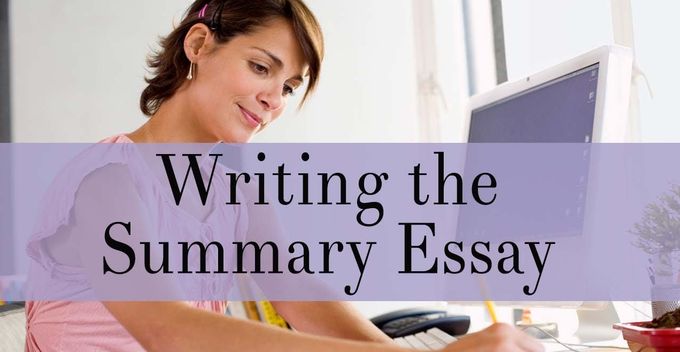How to Write a Summary of an Essay
Publication Date: 05 September 2022
It’s fair to say that a summary is the bread and butter of a student’s life. While in college, we learn to write summaries and find an example of an essay summary to better and faster understand voluminous original sources. Summarizing is a basic academic skill and its importance goes well beyond academia – virtually in every office job there is a need to quickly understand the main point of written material and to be able to convey complex ideas and concepts in simple terms.
Check out the below guide on how to write a summary of an essay, how to start a good summary, and where to find a perfect example of an essay summary.
What is a summary?

A summary is condensed information about an original work: book, article, essay, story, review, dissertation, research, etc. It is the essence of the source material, formulated in simple terms and short volume.
Contrary to popular belief, a summary is not an analytical piece of text. It doesn’t require the author to critique and assess the original text. On the contrary, it is an unbiased retelling of the original work. In a summary, we provide an accurate account of the source text, including the most critical ideas, concepts, statements, and thoughts. Copying text from the original is not allowed!
There is one specific feature common to all summaries – they are all shorter than the original text. This size reduction can be as much as 10 and 20 times, depending on the original text and its complexity. Nobody is going to read a summary of an essay that is several pages long!
Two types of summaries
Before we dive into practicalities and learn how to start a good summary, let’s quickly review the two types of summaries:
- Reader summary – this is a summary of other authors’ works. It is written for other readers and aims to better convey the key information. Basically, a reader summary means that you take other people’s text and write a summary (e.g. a summary of an essay) for your reader(s).
- Author summary – the key difference with the first type is that here the author writes a summary of their own work. To illustrate this point, let’s take an example of an essay summary – if your essay is 5 pages long, you may need to convey the essence of this text in just a few paragraphs.
How to identify the main idea?
Ask any senior student or a faculty member at college, ‘what is the key skill in writing a summary of an essay?’ and they will all say that it is the ability to identify the main idea of the text. To do this, you will need to write the whole piece and compare it against your experience and knowledge. One cannot write a good summary without a deep understanding of the material.
How to start? You will need to read the whole text once or several times, depending on your reading comprehension skills. Pick up any or all interesting facts, key arguments, and the author’s main statements (in an essay it is called a thesis statement). While reading the original text, consider taking notes. This is a healthy habit of all good writers and it teaches you to be attentive and precise in your arguments. Pay particular attention to the introductory part and the conclusion, as this is where the authors place their main arguments and conclusions. We even suggest you begin reading the source text with these two parts. No good example of an essay summary is possible without an analysis of an introduction or conclusion.
Sometimes an author would use complicated and figurative language. It is not necessary to convey the same in a summary, though such language can help you a lot in understanding the author’s character and analyzing their work.
Easy steps for writing a summary of an essay
Here is a perfect example of an essay summary writing algorithm. Follow it and you will have no problems summarizing an essay quickly and effectively.
- Carefully read the text. We recommend you read it several times, as reading for the first time, you may not grasp the essence. Try to get the feeling for the author’s original language, tone, and style – this will help you in your summary writing. Also, separate the text into logical parts. In most cases, this division is evident as the author has clearly separated the introductory part, the main part, and the conclusion.
- Make notes. If it is a paper copy you are reading, don’t be afraid to make notes within the text. You can underline certain areas and highlight the keywords and phrases. Each writer has their own way of making notes. To make sure you understood the text, we recommend you answer several questions:
- What is the key idea of this essay?
- What did the author want to say by writing this paper?
- What are the most interesting facts and arguments in the text?
- Create an outline of your summary. This will tremendously help you in how to start writing. In a classic essay summary, you should outline three parts: the introduction, the main part, and the conclusion. Use the highlights in the original text as well as your initial notes to create an outline.
- Write an introduction. Only a couple of sentences should be devoted to the introduction. State here the author’s ambitions and goals for the essay (such as a thesis statement). Remember, this is just a summary, not an original essay piece, as many students develop the habit of writing too much not knowing how to start their summary.
- Write the main part. The essence of the author’s main part should be reflected here. If the original piece has several big paragraphs, in the summary, it is not necessary to create an equal amount of paragraphs. Only the essential, only the key arguments. It is perfectly fine to drop some supplementary argumentation from the source text in the summary of an essay.
- Write the conclusion. Provide your interpretation of what the author wanted to say in the essay. Stay objective and avoid personal remarks and assessments – a summary is not a critique; it’s an unbiased and accurate record of the original text.
- Review and edit. Once you have finished your first draft, check it for logic and consistency. Compare it against the original text and make changes if required. Then, in the final stage, edit your text for grammar and language errors.
That’s it! Now you know how to start and finish a great summary of an essay. If you are still feeling uncertain and worried to begin doing this task alone, find a high-graded example of an essay summary either online or in your class and see how others have coped with the same assignment.
Also, have a look at our final checklist of what to do and what not to do when writing a summary of an essay.

Do
- Read the text several times;
- Make notes as you read (on paper or on your laptop);
- Create an outline of your summary first;
- As you write, stay objective and unbiased;
- Use correct referencing when citing the author;
- Shorten the original text by at least 10 times;
- Review and edit your draft.
Don’t
- Read the original essay carelessly and across the lines;
- Neglect to check a good example of an essay summary;
- Copy text from the original source;
- Critique, assess or blame the author;
- Interpret the original essay text from the prism of your knowledge and experience;
- Include all the details, especially if they are not essential for the understanding of the text;
- Submit your very first, unchecked draft.





